James Glass
MIT Computer Science and Artificial Intelligence Laboratory, MA, USA
LibriVAD: A Scalable Open Dataset with Deep Learning Benchmarks for Voice Activity Detection
Dec 19, 2025Abstract:Robust Voice Activity Detection (VAD) remains a challenging task, especially under noisy, diverse, and unseen acoustic conditions. Beyond algorithmic development, a key limitation in advancing VAD research is the lack of large-scale, systematically controlled, and publicly available datasets. To address this, we introduce LibriVAD - a scalable open-source dataset derived from LibriSpeech and augmented with diverse real-world and synthetic noise sources. LibriVAD enables systematic control over speech-to-noise ratio, silence-to-speech ratio (SSR), and noise diversity, and is released in three sizes (15 GB, 150 GB, and 1.5 TB) with two variants (LibriVAD-NonConcat and LibriVAD-Concat) to support different experimental setups. We benchmark multiple feature-model combinations, including waveform, Mel-Frequency Cepstral Coefficients (MFCC), and Gammatone filter bank cepstral coefficients, and introduce the Vision Transformer (ViT) architecture for VAD. Our experiments show that ViT with MFCC features consistently outperforms established VAD models such as boosted deep neural network and convolutional long short-term memory deep neural network across seen, unseen, and out-of-distribution (OOD) conditions, including evaluation on the real-world VOiCES dataset. We further analyze the impact of dataset size and SSR on model generalization, experimentally showing that scaling up dataset size and balancing SSR noticeably and consistently enhance VAD performance under OOD conditions. All datasets, trained models, and code are publicly released to foster reproducibility and accelerate progress in VAD research.
MetaCLIP 2: A Worldwide Scaling Recipe
Jul 29, 2025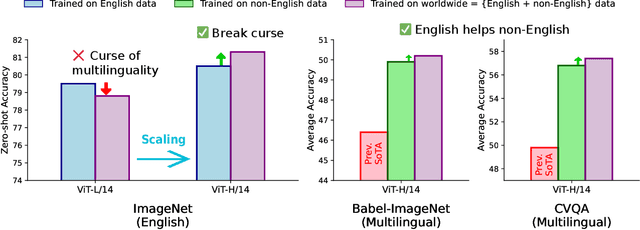

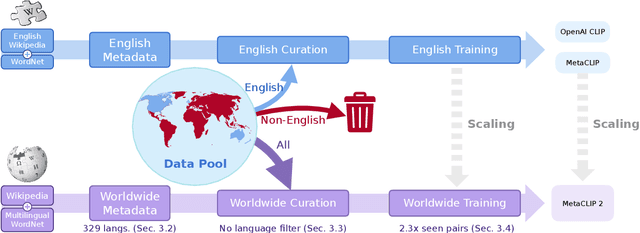

Abstract:Contrastive Language-Image Pretraining (CLIP) is a popular foundation model, supporting from zero-shot classification, retrieval to encoders for multimodal large language models (MLLMs). Although CLIP is successfully trained on billion-scale image-text pairs from the English world, scaling CLIP's training further to learning from the worldwide web data is still challenging: (1) no curation method is available to handle data points from non-English world; (2) the English performance from existing multilingual CLIP is worse than its English-only counterpart, i.e., "curse of multilinguality" that is common in LLMs. Here, we present MetaCLIP 2, the first recipe training CLIP from scratch on worldwide web-scale image-text pairs. To generalize our findings, we conduct rigorous ablations with minimal changes that are necessary to address the above challenges and present a recipe enabling mutual benefits from English and non-English world data. In zero-shot ImageNet classification, MetaCLIP 2 ViT-H/14 surpasses its English-only counterpart by 0.8% and mSigLIP by 0.7%, and surprisingly sets new state-of-the-art without system-level confounding factors (e.g., translation, bespoke architecture changes) on multilingual benchmarks, such as CVQA with 57.4%, Babel-ImageNet with 50.2% and XM3600 with 64.3% on image-to-text retrieval.
Beyond Context Limits: Subconscious Threads for Long-Horizon Reasoning
Jul 22, 2025Abstract:To break the context limits of large language models (LLMs) that bottleneck reasoning accuracy and efficiency, we propose the Thread Inference Model (TIM), a family of LLMs trained for recursive and decompositional problem solving, and TIMRUN, an inference runtime enabling long-horizon structured reasoning beyond context limits. Together, TIM hosted on TIMRUN supports virtually unlimited working memory and multi-hop tool calls within a single language model inference, overcoming output limits, positional-embedding constraints, and GPU-memory bottlenecks. Performance is achieved by modeling natural language as reasoning trees measured by both length and depth instead of linear sequences. The reasoning trees consist of tasks with thoughts, recursive subtasks, and conclusions based on the concept we proposed in Schroeder et al, 2025. During generation, we maintain a working memory that retains only the key-value states of the most relevant context tokens, selected by a rule-based subtask-pruning mechanism, enabling reuse of positional embeddings and GPU memory pages throughout reasoning. Experimental results show that our system sustains high inference throughput, even when manipulating up to 90% of the KV cache in GPU memory. It also delivers accurate reasoning on mathematical tasks and handles information retrieval challenges that require long-horizon reasoning and multi-hop tool use.
USAD: Universal Speech and Audio Representation via Distillation
Jun 23, 2025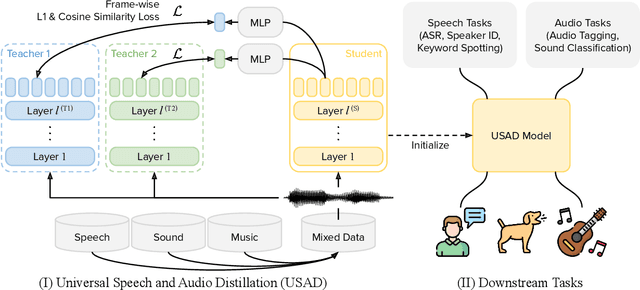
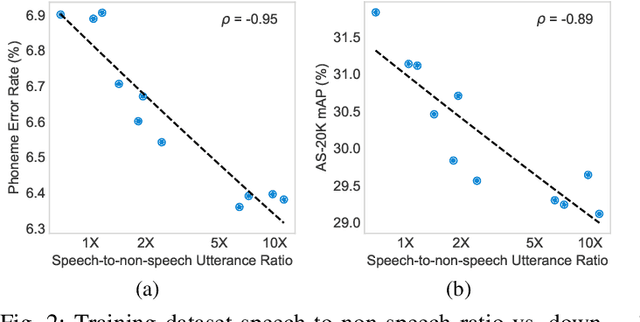
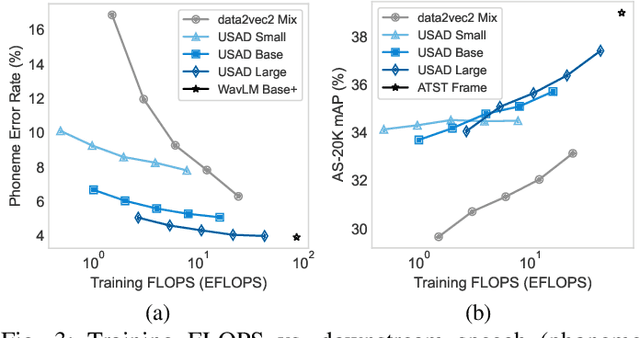
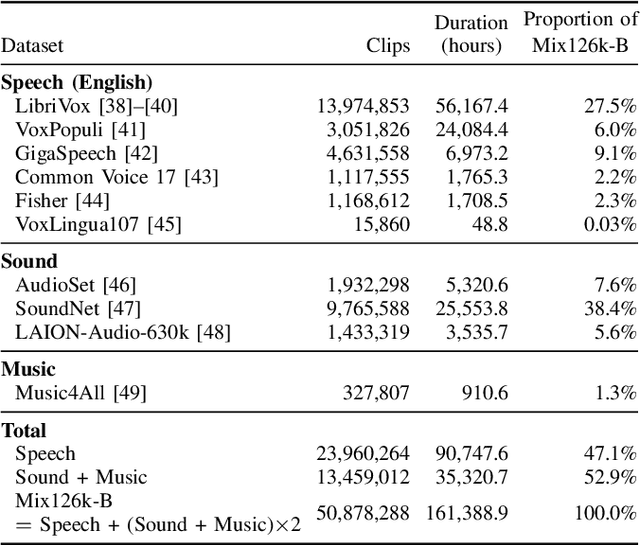
Abstract:Self-supervised learning (SSL) has revolutionized audio representations, yet models often remain domain-specific, focusing on either speech or non-speech tasks. In this work, we present Universal Speech and Audio Distillation (USAD), a unified approach to audio representation learning that integrates diverse audio types - speech, sound, and music - into a single model. USAD employs efficient layer-to-layer distillation from domain-specific SSL models to train a student on a comprehensive audio dataset. USAD offers competitive performance across various benchmarks and datasets, including frame and instance-level speech processing tasks, audio tagging, and sound classification, achieving near state-of-the-art results with a single encoder on SUPERB and HEAR benchmarks.
RAG-Zeval: Towards Robust and Interpretable Evaluation on RAG Responses through End-to-End Rule-Guided Reasoning
May 28, 2025



Abstract:Robust evaluation is critical for deploying trustworthy retrieval-augmented generation (RAG) systems. However, current LLM-based evaluation frameworks predominantly rely on directly prompting resource-intensive models with complex multi-stage prompts, underutilizing models' reasoning capabilities and introducing significant computational cost. In this paper, we present RAG-Zeval (RAG-Zero Evaluator), a novel end-to-end framework that formulates faithfulness and correctness evaluation as a rule-guided reasoning task. Our approach trains evaluators with reinforcement learning, facilitating compact models to generate comprehensive and sound assessments with detailed explanation in one-pass. We introduce a ranking-based outcome reward mechanism, using preference judgments rather than absolute scores, to address the challenge of obtaining precise pointwise reward signals. To this end, we synthesize the ranking references by generating quality-controlled responses with zero human annotation. Experiments demonstrate RAG-Zeval's superior performance, achieving the strongest correlation with human judgments and outperforming baselines that rely on LLMs with 10-100 times more parameters. Our approach also exhibits superior interpretability in response evaluation.
Instructify: Demystifying Metadata to Visual Instruction Tuning Data Conversion
May 23, 2025Abstract:Visual Instruction Tuning (VisIT) data, commonly available as human-assistant conversations with images interleaved in the human turns, are currently the most widespread vehicle for aligning strong LLMs to understand visual inputs, converting them to strong LMMs. While many VisIT datasets are available, most are constructed using ad-hoc techniques developed independently by different groups. They are often poorly documented, lack reproducible code, and rely on paid, closed-source model APIs such as GPT-4, Gemini, or Claude to convert image metadata (labels) into VisIT instructions. This leads to high costs and makes it challenging to scale, enhance quality, or generate VisIT data for new datasets. In this work, we address these challenges and propose an open and unified recipe and approach,~\textbf{\method}, for converting available metadata to VisIT instructions using open LLMs. Our multi-stage \method features an efficient framework for metadata grouping, quality control, data and prompt organization, and conversation sampling. We show that our approach can reproduce or enhance the data quality of available VisIT datasets when applied to the same image data and metadata sources, improving GPT-4 generated VisIT instructions by ~3\% on average and up to 12\% on individual benchmarks using open models, such as Gemma 2 27B and LLaMa 3.1 70B. Additionally, our approach enables effective performance scaling - both in quantity and quality - by enhancing the resulting LMM performance across a wide range of benchmarks. We also analyze the impact of various factors, including conversation format, base model selection, and resampling strategies. Our code, which supports the reproduction of equal or higher-quality VisIT datasets and facilities future metadata-to-VisIT data conversion for niche domains, is released at https://github.com/jacob-hansen/Instructify.
Don't "Overthink" Passage Reranking: Is Reasoning Truly Necessary?
May 22, 2025Abstract:With the growing success of reasoning models across complex natural language tasks, researchers in the Information Retrieval (IR) community have begun exploring how similar reasoning capabilities can be integrated into passage rerankers built on Large Language Models (LLMs). These methods typically employ an LLM to produce an explicit, step-by-step reasoning process before arriving at a final relevance prediction. But, does reasoning actually improve reranking accuracy? In this paper, we dive deeper into this question, studying the impact of the reasoning process by comparing reasoning-based pointwise rerankers (ReasonRR) to standard, non-reasoning pointwise rerankers (StandardRR) under identical training conditions, and observe that StandardRR generally outperforms ReasonRR. Building on this observation, we then study the importance of reasoning to ReasonRR by disabling its reasoning process (ReasonRR-NoReason), and find that ReasonRR-NoReason is surprisingly more effective than ReasonRR. Examining the cause of this result, our findings reveal that reasoning-based rerankers are limited by the LLM's reasoning process, which pushes it toward polarized relevance scores and thus fails to consider the partial relevance of passages, a key factor for the accuracy of pointwise rerankers.
Omni-R1: Do You Really Need Audio to Fine-Tune Your Audio LLM?
May 14, 2025

Abstract:We propose Omni-R1 which fine-tunes a recent multi-modal LLM, Qwen2.5-Omni, on an audio question answering dataset with the reinforcement learning method GRPO. This leads to new State-of-the-Art performance on the recent MMAU benchmark. Omni-R1 achieves the highest accuracies on the sounds, music, speech, and overall average categories, both on the Test-mini and Test-full splits. To understand the performance improvement, we tested models both with and without audio and found that much of the performance improvement from GRPO could be attributed to better text-based reasoning. We also made a surprising discovery that fine-tuning without audio on a text-only dataset was effective at improving the audio-based performance.
Overflow Prevention Enhances Long-Context Recurrent LLMs
May 12, 2025Abstract:A recent trend in LLMs is developing recurrent sub-quadratic models that improve long-context processing efficiency. We investigate leading large long-context models, focusing on how their fixed-size recurrent memory affects their performance. Our experiments reveal that, even when these models are trained for extended contexts, their use of long contexts remains underutilized. Specifically, we demonstrate that a chunk-based inference procedure, which identifies and processes only the most relevant portion of the input can mitigate recurrent memory failures and be effective for many long-context tasks: On LongBench, our method improves the overall performance of Falcon3-Mamba-Inst-7B by 14%, Falcon-Mamba-Inst-7B by 28%, RecurrentGemma-IT-9B by 50%, and RWKV6-Finch-7B by 51%. Surprisingly, this simple approach also leads to state-of-the-art results in the challenging LongBench v2 benchmark, showing competitive performance with equivalent size Transformers. Furthermore, our findings raise questions about whether recurrent models genuinely exploit long-range dependencies, as our single-chunk strategy delivers stronger performance - even in tasks that presumably require cross-context relations.
PLAY2PROMPT: Zero-shot Tool Instruction Optimization for LLM Agents via Tool Play
Mar 18, 2025



Abstract:Large language models (LLMs) are increasingly integrated with specialized external tools, yet many tasks demand zero-shot tool usage with minimal or noisy documentation. Existing solutions rely on manual rewriting or labeled data for validation, making them inapplicable in true zero-shot settings. To address these challenges, we propose PLAY2PROMPT, an automated framework that systematically "plays" with each tool to explore its input-output behaviors. Through this iterative trial-and-error process, PLAY2PROMPT refines tool documentation and generates usage examples without any labeled data. These examples not only guide LLM inference but also serve as validation to further enhance tool utilization. Extensive experiments on real-world tasks demonstrate that PLAY2PROMPT significantly improves zero-shot tool performance across both open and closed models, offering a scalable and effective solution for domain-specific tool integration.
 Add to Chrome
Add to Chrome Add to Firefox
Add to Firefox Add to Edge
Add to Edge